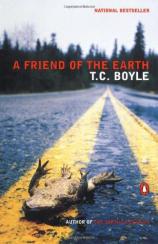Reading Group Guide
Discussion Questions
A Friend of the Earth

1. Although the novel argues for the preservation of biological diversity, none of the animals in the book evokes sympathy in the reader, and even the smallest proves deadly. Why would Boyle choose such unlikely poster animals for a novel about environmentalism, and what is he saying about nature and its interaction with humankind?
2. In this book, and previously in such works as The Road to Wellville, T.C. Boyle lingers over the descriptions of bodily functions, from Sierra's growing disgust with meat to Ty and Andrea's eating habits in the Sierra Nevada and his jokes about cannibalism to Ty's preparations with diapers in the Siskiyou. How do the themes of consumption and body functions tie into broader development of the character of Tyrone Tierwater and the issues in the novel?
3. As Ty begins to outpace his colleagues in Earth Forever!, his actions become more unhinged and terroristic and, arguably, even harmful to the environmental movement and the environment. Why is Ty committing these acts, and what do they say about the real reasons behind his embrace of environmentalism?
4. Both Ty's first wife, Jane, and his daughter die from accidents that are both nature-related. What influence does the blameless, almost absurd, manner of the deaths have on Ty's personality and his feelings about nature and himself?
5. As his ardor for activism grows, Ty's obsession with the love triangle between himself, Andrea, and Teo also increases. Why does Ty's jealousy spike between his bouts of increasingly destructive ecoterrorism? How are his feelings for Andrea reflected in his relationship to the Earth Movement?
6. Maclovio Pulchris: Vain, shallow, and culturally obsolete, this aging pop star nevertheless proves to be the best hope for rescuing whatever remains of the ecology of the twentieth century. April Wind is a doll-like, opportunistic journalist-cum-groupie who wants to mine Ty's past for a memoir about Sierra. What part of the U.S. of the future do these two characters represent, and what might Boyle be saying through his description of the brief, superficial affair between these two?
7. In the very last line of the book, Ty tells a Sierra-like girl fascinated by Petunia, the Patagonian fox: "That's right, that's right, she's a dog. And I'm a human being." Why does he make this declaration? What is the significance of the fact that one of these statements isn't technically true? And how is Ty's assertion of his own humanness a conclusion to his journey from his "life of quiet desperation" to the "Human Hyena" to the final pages of the book?
8. What conclusions can be drawn about the broader themes of age and aging in the book, whether that of Ty, Andrea, and Sierra, or the Earth itself? How does Boyle use the technique of shuttling from the past to the future to get his point across? What about his alternating use of the first- and third-person?
9. What is the effect of Ty and Andrea's naked sojourn in the Sierra Nevada? What does Ty learn from his time there? Why is there a contrast between the lack of sexuality between Ty and Andrea in the woods and with their relative concupiscence in 2025?
10. Ty's love of Sierra is the centerpiece of the narrative, spurring on many of his critical actions, even though many of those actions end up doing Sierra and him more harm than good. How does Ty and Sierra's bond evolve, and how do the themes of fatherhood and childhood recur throughout the novel?
11. What Biblical parallels do you recognize in A Friend of the Earth and how do they contribute to the book's impact?
A Friend of the Earth
- Publication Date: September 1, 2001
- Genres: Fiction
- Paperback: 368 pages
- Publisher: Penguin (Non-Classics)
- ISBN-10: 0141002050
- ISBN-13: 9780141002057








